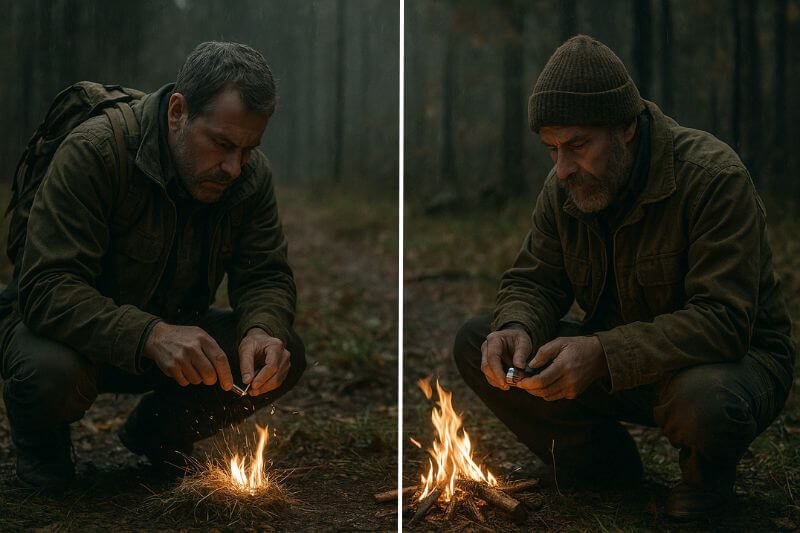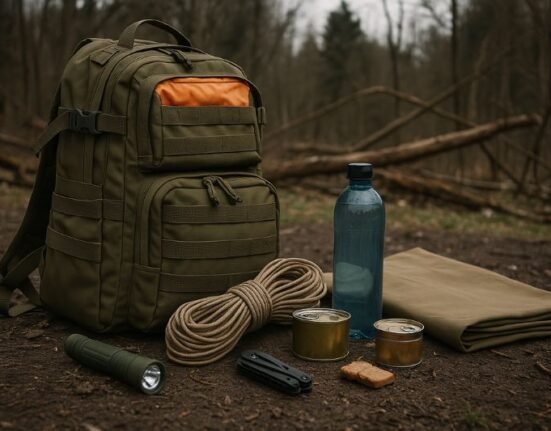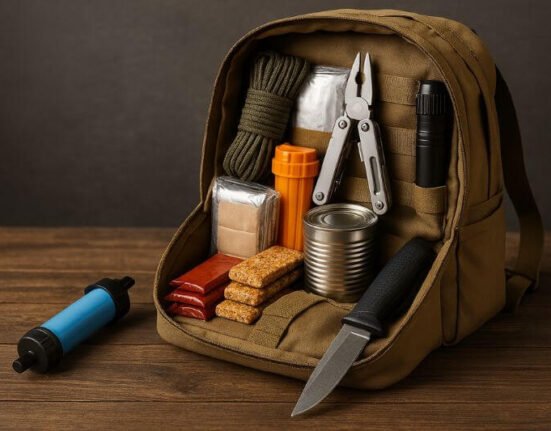In any crisis, cold is more than uncomfortable—it’s deadly. That’s why understanding your survival fire starters is critical. Fire provides heat, light, sterilization, cooking, and psychological stability. Without it, even the best gear won’t save you in the wild.
You might carry waterproof matches or a classic Zippo, maybe a ferro rod strapped to your knife sheath, or an electric plasma lighter in your pack—but have you tested them in wind, rain, or stress?
This article breaks down the essential fire starting tools for survival, comparing the strengths and weaknesses of each method. You’ll learn:
- Which tool performs best in harsh conditions
- How to create redundancy in your fire kit
- What kind of tinder to pair with each ignition method
- How to build a fire-starting system for your EDC, bug-out bag, or long-term camp
Whether you’re facing cold nights in the forest, grid-down conditions in the city, or a wet bug-out trail through the mountains, the ability to start fire can mean the difference between surviving the night—or not.
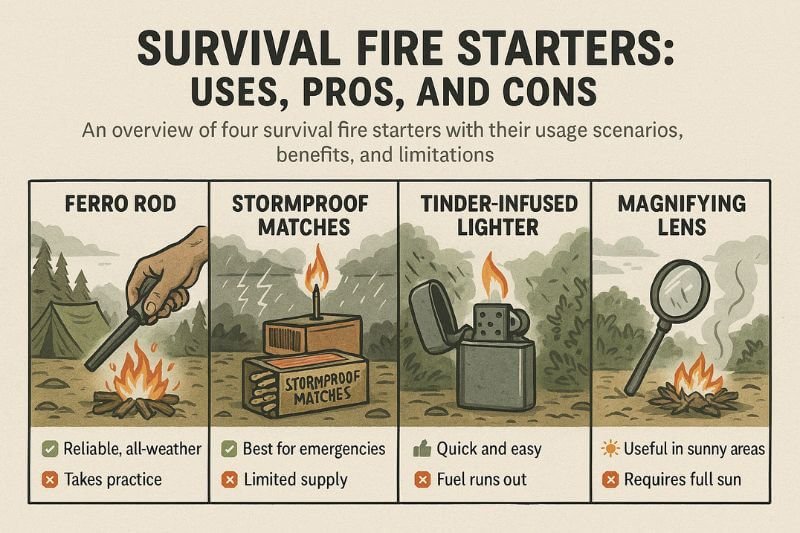
Why Fire Starters Are Essential in Any Survival Kit
🔥 The Psychology and Practicality of Fire in Survival
Fire is one of the oldest survival tools known to man, and it serves more than just a physical need. In high-stress survival scenarios, fire is reassurance. The flame stabilizes your mindset, keeps panic in check, and provides a sense of control over your environment.
From a practical standpoint, fire allows you to:
- Boil and purify unsafe water
- Cook wild game or food rations
- Sterilize tools and wounds
- Signal for rescue (smoke, light)
- Deter predators (animal or human)
- Dry soaked gear or clothing
- Provide warmth and comfort during cold nights
In many cold-weather case studies, hypothermia is often the first killer—not starvation. And that risk skyrockets without fire.
🧠 When Fire Is a Lifesaving Tool
Let’s say your GPS dies. Your phone battery’s drained. Your gear’s soaked. You’re alone, injured, or in the middle of a blackout. What’s your backup?
Your fire starter is no longer just a camping accessory—it’s a lifesaving system. It allows you to:
- Create a controlled environment
- Boost morale during extended isolation
- Extend battery life by drying equipment
- Heat water when fuel stoves fail
- Light up a shelter without drawing grid power
Even in urban collapse, fire allows you to cook safely when gas is cut, burn trash, or signal others.
✅ Without a reliable fire starter, even the most advanced bug-out bag has a critical vulnerability.
Types of Survival Fire Starters: Pros and Cons
Not all fire starters are created equal. In the chaos of survival—wet clothes, shaky hands, freezing wind—you need tools that work under pressure.
This section of the survival fire starters guide breaks down the four main ignition methods: matches, lighters, ferro rods, and tinder kits—so you can understand what works, when, and why.
🧨 Matches: Waterproof, Windproof, and DIY
Matches are classic, compact, and lightweight. But they’re also fragile unless upgraded.
✅ Pros:
- Ultra-lightweight and easy to use
- Available in waterproof or stormproof versions
- Can be made DIY with wax + strike strip
- Cheap and disposable
- Great for lighting dry tinder fast
❌ Cons:
- Limited supply—each match = one chance
- Easily ruined by moisture if not sealed
- Wind can extinguish regular matches
- Requires stable hand and dry striking surface
✅ Best Use Case:
• Backup firestarter in sealed waterproof capsule
• First-layer ignition tool in EDC kits
• Great in dry climates or indoors
🔥 Lighters: Butane, Refillable, and Electric Arcs
Lighters are the most common fire tool in everyday use. But not all are built for survival.
✅ Pros:
- Instant flame with minimal effort
- Refillable or disposable options
- Compact and one-handed
- Electric plasma lighters work at high altitudes
- Some include built-in flashlight or charger
❌ Cons:
- Butane models fail in cold or altitude
- Fuel evaporates in long-term storage
- Piezo igniters may fail when wet
- Electric models depend on battery charge
✅ Best Use Case:
• Urban prepping or daily carry
• Supplement to matches and ferro rods
• Reliable when tested monthly and kept full
⚠️ Pro tip: Tape a strike-anywhere match or two to your lighter with waterproof tape as backup.
⚡ Ferro Rods: Spark Power in Any Condition
Ferrocerium rods (often called ferro rods or firesteel) are a favorite among bushcrafters for good reason—they throw thousands of hot sparks, even when wet.
✅ Pros:
- Extremely durable (up to 10,000 strikes)
- Works when soaked, frozen, or muddy
- Lightweight and no fuel needed
- Can ignite dry grass, bark, or cotton easily
- Often includes striker and paracord lanyard
❌ Cons:
- Requires proper technique
- Needs dry or prepared tinder
- Not intuitive for beginners under stress
- Can damage blades if used with wrong tools
✅ Best Use Case:
• Long-term survival kits
• Bushcraft, backcountry, or off-grid use
• Backup for matches and lighters
🧠 Bonus: Practice before a real emergency. Ferro rods are reliable—but only in trained hands.
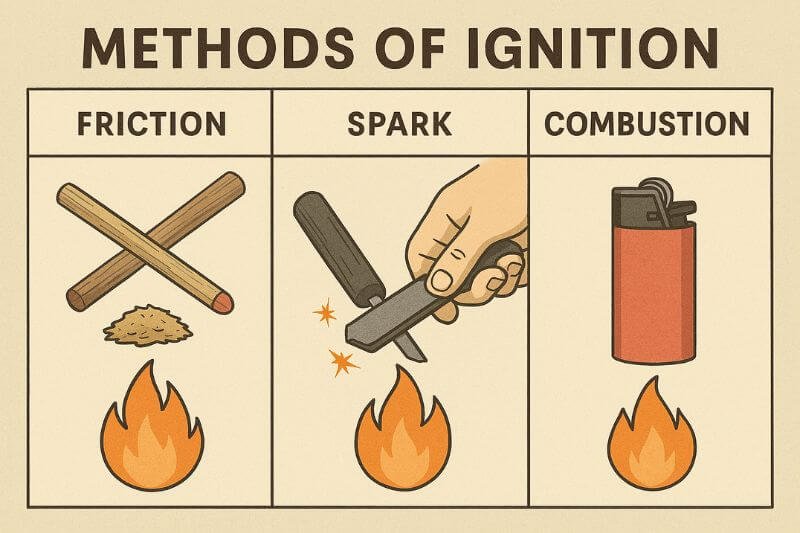
🪵 Tinder and Fire Starter Kits: Build or Buy?
Fire starters are nothing without tinder. Even the best ignition tool fails if there’s nothing dry to catch the flame.
🔥 Build your own:
- Cotton balls + petroleum jelly
- Dryer lint + wax in egg carton
- Birch bark, fatwood shavings, jute cord
🧰 Or buy pre-made kits:
- Waterproof cubes
- Magnesium fire bricks
- Compressed hemp or fiber pucks
✅ Best Use Case:
• Supplement to any ignition tool
• Pre-packed in kits, pouches, and bug-out bags
• Stored with each layer (EDC, BOB, home, car)
🧠 Survival Tip:
Layer your fire starting gear like your clothing. Each pack should have at least two ignition methods + tinder. Fire is too important to leave to chance.
How to Build a Redundant Fire Starting System
Even the best fire starter can fail. That’s why seasoned survivalists never rely on a single method. Instead, they build multi-layered, redundant systems that adapt to terrain, weather, and stress.
Let’s explore how to structure your survival fire starters for different kits and contexts—and why two is one, and one is none.
🎒 Layering Your Gear: EDC, Bug-Out, Basecamp
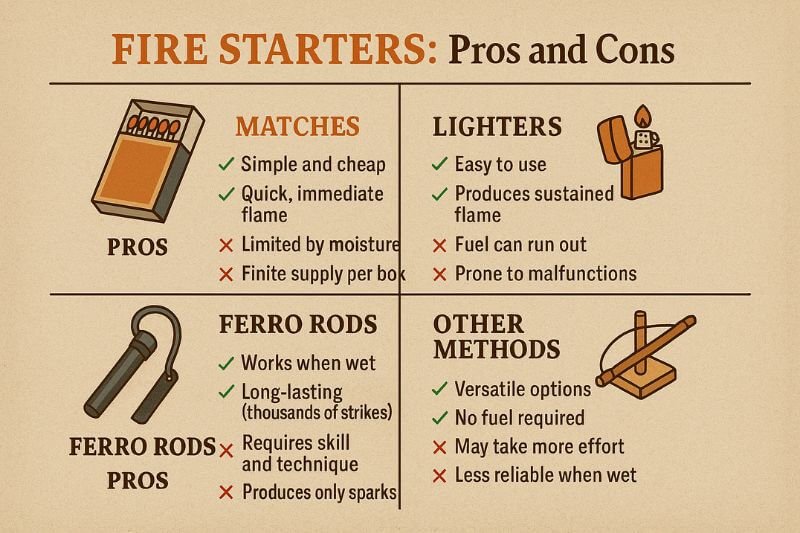
Each level of your preparedness setup should include its own fire solution, not just your primary bug-out bag.
| Level | Fire Tools to Include |
|---|---|
| EDC (Everyday Carry) | Mini ferro rod, refillable micro-lighter, tinder tab in wallet |
| Bug-Out Bag (72h) | Waterproof matches, main ferro rod, lighter, tinder kit in dry pouch |
| Basecamp / Shelter | Large ferro rod, solar or battery plasma lighter, backup fuel, full tinder stash |
✅ All kits should include:
- 2 ignition tools minimum
- At least one waterproof tinder option
- Backup inside a sealed, crush-proof container
🌧️ Environmental Factors: Wind, Rain, Snow
Not all fire starters perform equally in different climates.
| Condition | Best Option | Why |
|---|---|---|
| Rain / Wet Gear | Ferro rod + waxed cotton + knife blade | Sparks penetrate moisture |
| Windy terrain | Butane lighter with windscreen | Flame stability is key |
| Snow / Ice | Magnesium block or plasma lighter | Heats fast and melts ignition spot |
| Tropical humidity | Waterproof matches + jute + wax fire tab | Starts fast despite dampness |
✅ Pro tip: Store your primary fire kit in a waterproof container, and a backup on your body (belt pouch, neck lanyard, jacket pocket).
🔥 Field Testing: Reliability Under Pressure
Don’t trust your life to gear you haven’t tested.
Test each item by:
- Lighting a fire in wind or rain
- Striking your ferro rod with gloves on
- Using only your off-hand
- Starting a fire after soaking tinder for 30 seconds
- Building a flame in under 2 minutes using only what’s in your pack
✅ A fire starter is only as reliable as your skill. Practice under pressure, in the dark, with cold fingers. That’s when it really counts.
🧠 Final Word
Fire is one of the few survival tools that offers warmth, security, signaling, and hope all at once. Build your system like your life depends on it—because in the cold and dark, it might.
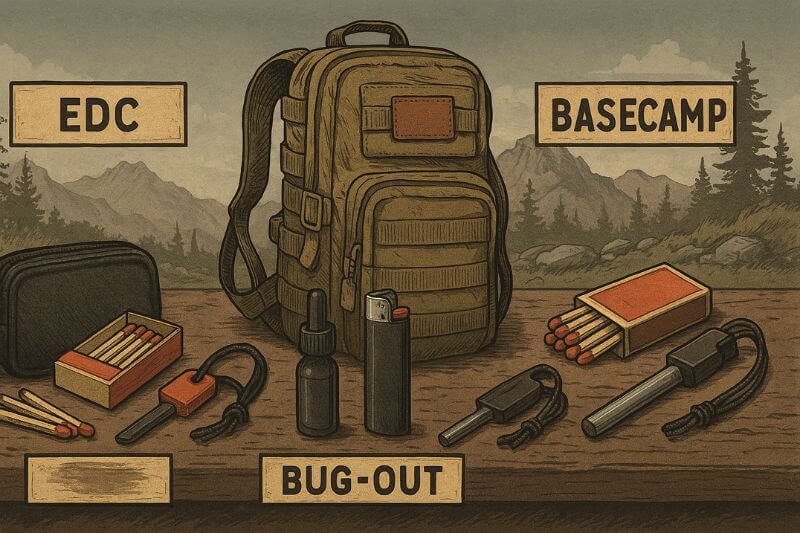
Survival Fire Starters Compared: Which Tool Matches Your Strategy?
| Fire Starter | Best Use Case | Main Pros | Main Cons | Recommended Gear Pairing |
|---|---|---|---|---|
| Matches | EDC kits, dry climates, indoor fires | Lightweight, easy to use, waterproof versions available | Single-use, moisture sensitive, wind vulnerable | Stormproof container + backup lighter |
| Lighters | Urban prepping, daily carry, supplement tool | Instant flame, refillable, electric versions for altitude | Fuel evaporation, cold sensitive, piezo failures | Mini ferro rod taped on + waterproof tinder |
| Ferro Rods | Long-term kits, off-grid, bushcraft | Works when wet, no fuel needed, long lifespan | Needs practice, requires dry tinder, sparks not flame | High-efficiency tinder (jute, fatwood, cotton) |
| Tinder Kits | All kits – EDC, BOB, shelter (as fire support) | Supports all ignition methods, various formats (DIY or pre-made) | Useless without ignition source, can be bulky | Ferro rod + stormproof matches |
❓ Frequently Asked Questions (FAQ)
🌧️ Which fire starter works best in wet conditions?
In wet or humid survival scenarios, your choice of fire starter can make or break your night.
✅ The most reliable in wet conditions is the ferro rod, especially when paired with:
- Waxed cotton balls or dryer lint
- Fatwood shavings or birch bark
- Magnesium scrapings (ignites fast, burns hot)
Why it works:
- Ferro rods throw sparks at ~3,000°C (5,400°F)
- They ignite even after being submerged in water
- No fuel to leak, no wick to dry
⚠️ Matches and lighters struggle when wet unless specifically stormproof or stored airtight. Always keep tinder and striker in waterproof containers.
🔥 How long does a ferro rod last in real use?
Ferro rods are one of the longest-lasting survival fire starters, making them ideal for off-grid or long-term prepping.
Typical lifespan:
- Standard ferro rod (6″ x 0.5″) = ~10,000 strikes
- Each strike can start 1 fire (if done properly)
- With average use, one rod can last years
Best practices to extend lifespan:
- Use the flat spine of a knife, not the blade
- Avoid unnecessary strikes during practice
- Keep the rod dry and store with a protective cap
✅ A quality ferro rod is one of the most dependable fire tools available—especially for minimalist bug-outs or remote bushcraft.
💨 Are stormproof matches worth it?
Absolutely—especially as a secondary fire starter in your kit.
Stormproof matches are:
- Long-burning (up to 15 seconds)
- Wind-resistant
- Ignite even when wet
- Often come with a sealed striker case
But they have limits:
- Limited quantity—each match = one chance
- Heavier and bulkier than regular matches
- Need dry tinder unless you also pack fire cubes or jute rope
✅ Use stormproof matches to ignite larger kindling when conditions are too rough for regular matches or lighters.
🧠 Combine with fatwood or waxed jute for guaranteed fire, even during a thunderstorm.
🔋 Can you rely on a lighter for long-term survival?
Only if you prepare and back it up properly.
Lighters are great for everyday use but have weaknesses:
- Butane evaporates over time
- Piezo igniters break when wet or frozen
- Cold temperatures reduce performance
Tips to make a lighter reliable long-term:
- Choose a refillable metal lighter (e.g., Zippo or Thunderbird)
- Keep spare flints and fuel
- Use a plasma lighter with solar USB charging for redundancy
- Tape a ferro rod to your lighter for instant backup
✅ Rule of thumb: One lighter is never enough. Carry it, but never depend on it alone. Redundancy is how you survive the unexpected.









